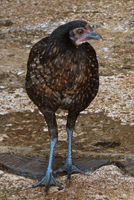

Posted on 12/13/2007 1:03:09 PM PST by blam
2007—Year of the Lapita?
Volume 61 Number 1, January/February 2008
by Mark Rose
Polynesian Breakthroughs


A Polynesian chicken (Anita Gould) and a Chilean chicken bone (Courtesy Alice Storey)
There was no doubt about including in our 2007 Top Ten the discovery that chicken bones from ancient Polynesian sites in Tonga and Samoa and El Arenal, a Chilean site occupied between A.D. 700 and 1390, had identical DNA. The chicken was domesticated in Southeast Asia, but how it arrived in the New World before Europeans arrived was a mystery. Now it seems that Polynesian seafarers brought them, adding to the evidence for trans-Pacific contacts. The presence of South American sweet potatoes and bottle gourds on Pacific islands had already hinted at this, along with some (to my mind less convincing) evidence that complex fishhooks and sewn plank canoes used by southern California Indians had Polynesian origins.
But the chicken story was just one of several breakthroughs made--or reported--this year that attest Polynesian seafaring abilities and provide new evidence about the origins and culture of the Lapita people, the ancestors of the Polynesians who colonized the Pacific. Taken together these findings could justify calling 2007 the Year of the Lapita.
Archaeologists Kenneth Collerson and Marshall Weisler from the University of Queensland analyzed 19 stone adzes collected early last century in the Tuamotu Archipelago, more than 1,000 miles southeast of Tahiti. By comparing the chemical signatures of the stone with basalt sources throughout the Pacific, they traced the artifacts to the Marquesas, Austral and Society Islands, and Pitcairn. One adze came from Kaho'olawe, a Hawaiian island far to the northwest. It supports a Hawaiian oral tradition of voyages across the southeast Pacific, and at 2,500 miles it's the longest known non-stop sea voyage in prehistory. These results suggest that trade was widespread within eastern Polynesia, but it, like the chicken DNA study, doesn't necessarily indicate the intensity of such interactions.

Two men and an adze: Marshall Weisler (left) and Kenneth Collerson (University of Queensland)
Where these formidable navigators came from has been debated for years. One model is that the Lapita originated in Taiwan and traveled south and east to New Guinea, then out into the Pacific islands. An alternative is that about 3,500 years ago various aspects of the Lapita--people, language, and culture--came together in Indonesia, then spread.
In a pig DNA study, geneticist Greger Larson and his colleagues analyzed 781 modern and ancient pig specimens along possible migration routes and in the Pacific. They found no evidence along the Taiwan-Philippines route for early pigs with the same genetic signature as those that dominate in the Pacific today (instead they found only recently introduced East Asian domestic pigs). Larson says that if the Lapita spread from Taiwan, they didn't bring pigs with them. Larson's team did find another type of pig, which spread at an earlier date from a more southern route, out of Vietnam, through the Malay Peninsula into the Indonesian islands, to New Guinea, and into Polynesia. So, the pig DNA evidence suggests a more complex process for the formation of the Lapita cultural complex and Pacific colonization of than a simple "out of Taiwan" model.
One reason the Lapita have been so debated is that, although we have their artifacts, such as distinctive pottery, we haven't had the people--until now. Matthew Spriggs of the Australian National University, with the Vanuatu National Museum, has excavated a Lapita cemetery at Teouma, on the south coast of the island of Efate. It's a major piece or research, but one shortcoming of our Top Ten list is a question of dates. The cemetery was actually dug in 2004-2006, so, while preliminary results reached the public in February 2007, we didn't include it in our list this year.
What did Spriggs find? Or, just as important, what didn't he find? Try 70 burials, all of adults and none of children. Try only seven skulls. DNA analysis of the remains may give reveal the genetic background of the Lapita, and pinpoint their origins, whether only in Taiwan or a mix of populations. But biology and culture are two different things, and what we are learning about Lapita culture from this site is fascinating. Take the missing children. Spriggs says it could be that children below 16 were not considered full members of society and were buried elsewhere. The skulls? Perhaps the missing ones were removed after burial and placed in a shrine or house, practices known historically in the Pacific (the head was believed to be the seat of the soul). Of the seven skulls found, three were on one man's chest, three more were between the legs of a second man, and the seventh was in a pot. Three comes up elsewhere at the cemetery--a pile of bones atop three jaws, pots with three handles--and it could be the number had special significance to the Lapita.
No matter how you date discoveries or publication of archaeological research, we will likely look back on 2007 as a watershed year for our understanding of the Lapita and the colonization of the Pacific.
Found: a real old man of the sea
12-13-2007
Scholars revive idea using linguistic ties, Indian headdress
olynesians sailed to Southern California a millennium before Christopher Columbus landed on the East Coast.Key new evidence comes from two directions. The first involves revised carbon-dating of an ancient ceremonial headdress used by Southern California's Chumash Indians. The second involves research by two California scientists who suggest that a Chumash word for "sewn-plank canoe" is derived from a Polynesian word for the wood used to construct the same boat.
The scientists, linguist Kathryn A. Klar of UC Berkeley and archaeologist Terry L. Jones of Cal Poly San Luis Obispo, had trouble getting their thesis of ancient contact between the Polynesians and Chumash published in scientific journals. The Chumash and their neighbors, the Gabrielino, were the only North American Indians to build sewn-plank boats, a technique used throughout the Polynesian islands.
No children...suggests a large group of advance scouts, or warriors, or possibly exiles (criminals).
they’re wiley
scritch yer eyes out, they will
they’ve got giant, poisonous fangs and TALONS
We have some frosting with your name on it.
It is lonley frosting.
So sad.
So alone.
So cold.
shiver
|
|
|||
Gods |
Thanks Blam. Somehow I missed this one last week. Found it while searching for "Top 10" topic. Just adding to the catalog, not sending a general distribution. |
||
|
· Mirabilis · Texas AM Anthropology News · Yahoo Anthro & Archaeo · · History or Science & Nature Podcasts · Excerpt, or Link only? · cgk's list of ping lists · |
|||
Disclaimer: Opinions posted on Free Republic are those of the individual posters and do not necessarily represent the opinion of Free Republic or its management. All materials posted herein are protected by copyright law and the exemption for fair use of copyrighted works.